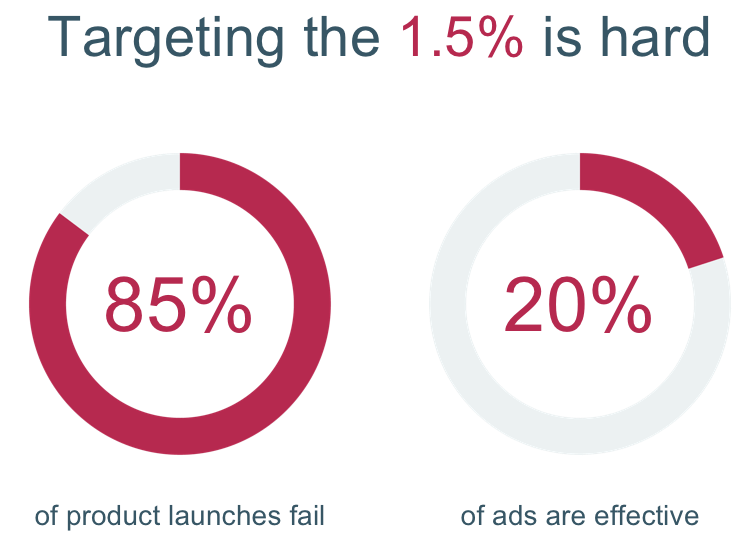Webinar Recap: Using Data to Bridge Strategy and Activation in an Agile Way
Using data to bridge strategy and activation sounds complicated, and it is. But we’ve developed a new solution that focuses on agility and quality to make it an easier process. Simply put, we leverage both survey data and big data to learn more about audiences and how to target them. Essentially, we’re looking to identify an audience, understand them, and be able to activate them as it relates to the product and communications we build as businesses. Other processes for activation strategies encompass this in some form or another, but often they do so in separate pieces leading to disconnected insights and potential data that isn’t actually actionable.
Previous Processes
1.5% of shoppers decide the success of a new CPG product within the first year.

This small percentage of the market typically consists of high volume users—and almost every industry outside of CPG can relate to this problem. However, the issue with this is that targeting that small of a population is incredibly difficult. Thus, 85% of product launches fail, and only 20% of our ads are effective.
As a result, strategies have almost always been focused on product, price, place, promotion, and most importantly people. Previously applied processes for activation, like the one below, is no different:
- Identifying & Understanding Customers: Often through the use of segmentation studies coupled with syndicated data, purchase data, or gut instincts.
- Testing Products: Usually through the testing of products against norms.
- Testing ads: Testing ads against other ads and not always with the ability to focus on the target market.
- Activating: Media planning, buying, and targeting at a high level.
The process above is not well suited when you need to target 1.5% of customers, especially since each stage is disconnected from the other. Some companies resort to paying more for advertising as a solution. In fact, $600 billion is spent annually on advertising worldwide. But we can do better than to resort to excessive advertising spend by using analytics and market research together.
A New Approach
A better approach involves identifying the right audience, understanding them to create the right products and messaging, and activating against that—all in a dynamic, agile way. How? Through survey data and big data. By combining the two, you can identify a market opportunity, then understand your target audience, and incorporate findings into your messaging and creative execution. This process works by
- Identifying target audiences with a survey
- Tagging the target audience and segmenting them out
- Onboarding the data into a data management platform (DMP)
- Building models for the data (demographics, behaviors, interests, personality, and triggers to purchase)
The result is unique audience intelligence. Overall, the benefits of this approach mean removing the guesswork during activation, letting the audience identify the opportunity for you, creating more effective messaging, and ultimately increasing value on ad purchases. To walk through a detailed case study and see this process in action, watch the full webinar. You’ll also learn
- More about the tools and processes we have at our disposal—and why a lot of them aren’t up to par
- About why it’s important to be able to better identify audiences in a dynamic, agile way
Written By
Learn how GutCheck’s Persona Connector solution leverages a combination of survey and big data to bring actionability to persona development.
Follow us on
Check Out Our Most Recent Blog Posts
When Vocation and Avocation Collide
At GutCheck, we have four brand pillars upon which we build our business. One of those is to 'lead...
Reflections on Season 1 of Gutsiest Brands
Understanding people is at the heart of market research. Sure, companies want to know what ideas...
Permission to Evolve with Miguel Garcia Castillo
(highlights from Episode #22 of the Gutsiest Brands podcast) Check out the latest lessons from our...
1-877-990-8111
[email protected]
© 2023 GutCheck is a registered trademark of Brainyak, Inc. All rights reserved.
© 2020 GutCheck is a registered trademark of Brainyak, Inc. All rights reserved.




